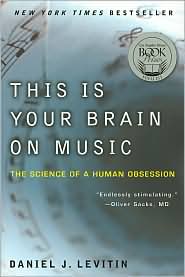A Review Of Daniel Levitin’s This Is Your Brain On Music
ISBN: 978-0-452-28852-2
Physicist Emerson Pugh once quipped, “if the human brain were so simple that we could understand it, we would be so simple that we couldn’t” [1]. In his book This Is Your Brain On Music neuroscientist Daniel Levitin notes how the number of ways that brain neurons can connect is so vast that we will never fully comprehend all the thought processes that we are capable of.
In recent years, mapping techniques have revealed a lot about the functional regions of the brain. Wernicke’s area is responsible for language processing, the motor cortex for physical movement and frontal lobes for generating personalities. Both encephalography and MRI have given us key spatial-temporal data about brain function in these regions. But we also find that activities such as listening to music contravene such a simplistic compartmentalization.
In fact the perception of pitch, tempo, the emotions invoked by a piece of music and the lyrics of a song all use different parts of the brain albeit simultaneously. Levitin repeatedly emphasizes the multi-faceted aspects of the music ‘experience’ noting how a, “precision choreography of neurochemical release and uptake” leads to our appreciation of music. The brain is thus a massively parallel device, capable of carrying out several different tasks at once.

